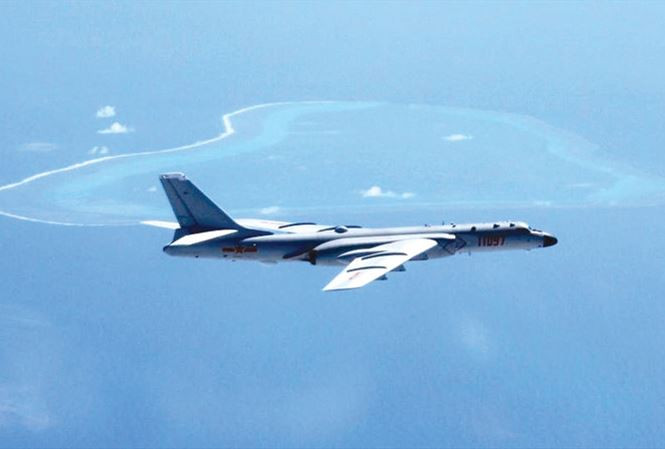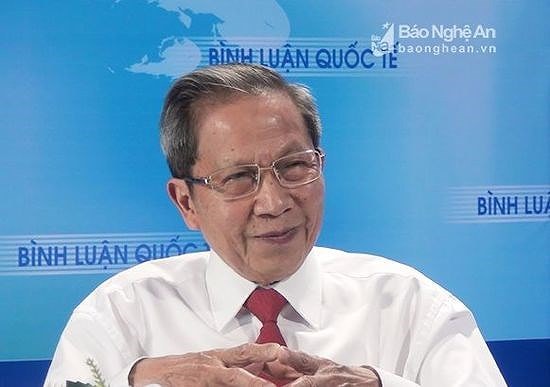China's militarization of the East Sea - a dangerous move!
(Baonghean.vn) - Before the press reported that China brazenly sent an aircraft capable of carrying nuclear bombs to Phu Lam Island in Vietnam's Hoang Sa archipelago, Nghe An Newspaper reporters interviewed Associate Professor, Dr. Major General Le Van Cuong, former Director of the Institute of Strategy and Science of the Ministry of Public Security, to discuss a number of issues from a researcher's perspective.
PV:Dear Major General, public opinion believes that sending strategic bombers to Hoang Sa this time is not an isolated action, but a link in China’s plot to monopolize the East Sea. Could you tell readers some information about China’s plot and condemnable actions against Vietnam’s East Sea?
Major General Le Van Cuong:For this problem, we must first start with the Agreement.Geneva was signed on July 20, 1954. Specifically, the parties to the Geneva Agreement committed to respecting the independence, sovereignty, and territorial integrity of Vietnam, including the Hoang Sa and Truong Sa archipelagos. The signing of the Geneva Agreement is not only a milestone in the history of the nation, but also the most important international legal document showing solid evidence, affirming the sovereignty of the Hoang Sa and Truong Sa archipelagos of Vietnam. China is also the country that drafted and signed. However, after 2 years of the Geneva Agreement, China invaded and occupied the Phu Lam archipelago of the Hoang Sa and Truong Sa archipelagos of Vietnam.
On April 19, 1974, China occupied the entire Paracel Islands. On March 14, 1988, China used force to occupy 7 of Vietnam's Paracel and Spratly Islands, including Vành Khăn.
 |
| Image of H-6K bomber operating in the sky over the East Sea area, July 2016. Photo: Internet |
The summary of China's actions in using force to occupy the Paracel and Spratly Islands shows that they have violated Article 2, Clause 3, and Clause 4 of the United Nations Charter. It states that UN members resolve disputes by peaceful means on the basis of international law; prohibit countries from using force in international relations, especially prohibiting the use of force to violate the sovereignty and territorial integrity of other countries. The content of this provision in the United Nations Charter is a fundamental principle of international law, requiring all member countries of the United Nations, including China, to comply.
In addition, China also violated Resolution 2625 dated October 24, 1970 of the United Nations General Assembly, which stated: “The territory of a State shall not be the object of military occupation resulting from the use of force in contravention of the provisions of the Charter of the United Nations. The territory of a State shall not be the object of acquisition by another State resulting from the threat or use of force. Any territorial acquisition resulting from the threat or use of force shall not be recognized as legal.”
PV:Dear Major General, through the process of invading the Hoang Sa and Truong Sa archipelagos, how has China militarized the East Sea?
Major General Le Van Cuong:After occupying the Paracel Islands and some islands in the Spratly Islands, China proceeded in two steps. Specifically, step 1 was to build artificial reefs in 4 years (2013 - 2016). Accordingly, China built on 7 rocky islands: Chau Vien, Xu Bi, Gac Ma, Vanh Khan, Ga Ven, Tu Nghia, Chu Thap with an area of more than 1,000 hectares, 17 times larger than the area of all the countries building on the Paracel Islands and the Spratly Islands combined.
In February 2016, China installed two batteries with nine HQ9 missile launchers on Phu Lam Island in Vietnam's Hoang Sa archipelago. (HQ9 has a range of about 200km, can aim at an altitude of 27.5km and can establish a large no-fly zone over the Hoang Sa archipelago).
In late 2014 - 2015, China built airports on Gac Ma, Vanh Khan and Xu Bi islands with runways of 2,500 - 3,400m. In 2016, China installed high-frequency radar for military purposes on 4 islands: Ga Ven, Gac Ma, Tu Nghia, Chau Vien. Accordingly, China has the ability to detect and give early warning of foreign aircraft and ships passing through the Strait of Malacca and the East Sea.
In August 2016, China built Chinese aircraft hangars that can hold a minimum of 21 aircraft and a maximum of 72 aircraft.
The People's Liberation Army Air Force (PLAAF) announced on May 18 that it had organized a multi-type bomber formation, including the H-6K, to fly for the first time into the "Southern Sea", an area believed to be Phu Lam Island in Vietnam's Hoang Sa archipelago, which is illegally occupied by China. The H6K is China's most modern strategic bomber, capable of carrying supersonic cruise missiles to carry out strategic attacks on land targets and warships.
The H-6K can carry the CJ-10A cruise missile with a range of up to 2,500km and an accuracy of 10m. It can hang 6 missiles externally and carry 1 in the compartment or carry 20 500kg unguided bombs, or high-precision laser-guided missiles. The amount of fuel carried increases from 34,360kg to 40,000kg, the H-6K's flight range increases to about 8,000km, the combat radius increases to 3,500km, and the amount of weapons carried can increase to 12 tons. Thus, by bringing the H6K strategic bomber to Phu Lam Island, China is fully capable of controlling all Southeast Asian ASEAN countries and controlling the US military base in northern Australia.
PV:Dear Major General, what is China's goal in sending H6K to Hoang Sa? And why did China send H6K strategic bombers at this time?
Major General Le Van Cuong:In my opinion, China's goal of sending strategic bombers to Hoang Sa is to dominate and control the entire East Sea. At the same time, it warns all countries that the activities of ships passing through the East Sea are closely monitored by China, and when necessary, they are ready to open fire. In addition, China's militarization of the East Sea aims to prevent and push the US out of this area, turning the East Sea into an area under China's influence.
 |
| Associate Professor, Dr. Major General Le Van Cuong comments from a researcher's perspective. Photo courtesy |
China is very serious and carefully considers the most appropriate time to send H6K strategic bombers to Phu Lam Island - Hoang Sa Vietnam. Specifically, after the 19th Congress of the Communist Party of China, General Secretary and President Xi Jinping firmly grasped power and removed Clause 3, Article 79 of the 1982 Constitution, which limits the term of office of the President and Vice President to two terms. The economy has developed quite well and accumulated enormous economic potential in agriculture, industry, science and technology and military strength.
The foreign situation has many advantages, President Donald Trump has pushed the US into a new crisis after 16 months in power, European allies have lost confidence in the US; the role and position of the US is increasingly declining. Europe is in an internal political crisis, immigration and terrorism... Besides, the 10 ASEAN countries have not yet created a high level of unity on the East Sea issue. This is the most favorable opportunity and the most appropriate time at home and abroad.
PV:Public opinion holds that China’s militarization of the East Sea is not only a violation of the law but also a contradiction of its commitments. How do you comment and explain this issue?
Major General Le Van Cuong:I completely agree with public opinion when China has a series of actions to militarize the East Sea, the most recent dangerous action of which is sending H6K strategic bombers to Vietnam's Hoang Sa archipelago; violating the United Nations Charter; violating the Convention on the Law of the Sea; violating the Declaration on the Conduct of Parties in the East Sea (DOC) that China signed with ASEAN (2002) in Phnom Penh, Cambodia.
In terms of foreign affairs, they have gone against their commitment to ASEAN countries to maintain the status quo in Vietnam-Vietnam relations and agree on six principles of conduct to resolve disputes in the East Sea. During his official visit to Vietnam, President Xi Jinping also signed a joint statement between Vietnam and China, which reaffirmed the two sides' commitment to ensuring peace and stability in the region. Notably, at an international press conference at the White House, President Xi Jinping declared that China would not militarize the East Sea. However, in reality, China has gone against its commitment and international law.
I think that Vietnam and the international community must speak out in protest, relying on the strength of the international community to be able to deter further actions by China.
PV:Thank you, Associate Professor, Dr. Major General Le Van Cuong, for this interview!

